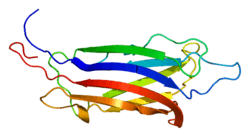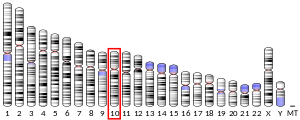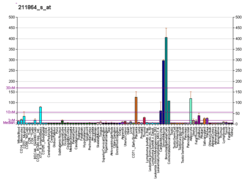Myoferlin
Myoferlin is a protein that in humans is encoded by the MYOF gene.[5][6][7][8]
Mutations in dysferlin, a protein associated with the plasma membrane, can cause muscle weakness that affects both proximal and distal muscles. The protein encoded by this gene is a type II membrane protein that is structurally similar to dysferlin. It is a member of the ferlin family and associates with both plasma and nuclear membranes. Myoferlin contains C2 domains that play a role in calcium-mediated membrane fusion events, suggesting that it may be involved in membrane regeneration and repair. Myoferlin also contains a FerA domain. FerA domains have been shown to interact with the membrane, suggesting that FerA domain in myoferlin may contribute to myoferlin's membrane interaction mechanism.[9] Myoferlin is overexpressed in several types of cancers, especially triple-negative breast cancer. Overexpression of myoferlin is associated with proliferation, migration and invasion of cancer cells and silencing myoferlin's gene in triple-negative breast cancer can significantly reduce tumor growth and metastatic progression.[10] Two transcript variants encoding different isoforms have been found for this gene. Other possible variants have been detected, but their full-length natures have not been determined.[8]
References
- GRCh38: Ensembl release 89: ENSG00000138119 - Ensembl, May 2017
- GRCm38: Ensembl release 89: ENSMUSG00000048612 - Ensembl, May 2017
- "Human PubMed Reference:". National Center for Biotechnology Information, U.S. National Library of Medicine.
- "Mouse PubMed Reference:". National Center for Biotechnology Information, U.S. National Library of Medicine.
- Davis DB, Delmonte AJ, Ly CT, McNally EM (Feb 2000). "Myoferlin, a candidate gene and potential modifier of muscular dystrophy". Hum Mol Genet. 9 (2): 217–26. doi:10.1093/hmg/9.2.217. PMID 10607832.
- Britton S, Freeman T, Vafiadaki E, Keers S, Harrison R, Bushby K, Bashir R (Nov 2000). "The third human FER-1-like protein is highly similar to dysferlin". Genomics. 68 (3): 313–21. doi:10.1006/geno.2000.6290. PMID 10995573.
- Bernatchez PN, Acevedo L, Fernandez-Hernando C, Murata T, Chalouni C, Kim J, Erdjument-Bromage H, Shah V, Gratton JP, McNally EM, Tempst P, Sessa WC (Oct 2007). "Myoferlin regulates vascular endothelial growth factor receptor-2 stability and function". J Biol Chem. 282 (42): 30745–53. doi:10.1074/jbc.M704798200. PMID 17702744.
- "Entrez Gene: FER1L3 fer-1-like 3, myoferlin (C. elegans)".
- Harsini, Faraz M; Chebrolu, Sukanya; Fuson, Kerry L; White, Mark A; Rice, Anne M; Sutton, Roger B (19 July 2018). "FerA is a Membrane-Associating Four-Helix Bundle Domain in the Ferlin Family of Membrane-Fusion Proteins". Scientific Reports. 8 (1): 10949. doi:10.1038/s41598-018-29184-1. PMC 6053371. PMID 30026467.
- Blomme, A; Costanza, B; de Tullio, P; Thiry, M; Van Simaeys, G; Boutry, S; Doumont, G; Di Valentin, E; Hirano, T; Yokobori, T; Gofflot, S; Peulen, O; Bellahcène, A; Sherer, F; Le Goff, C; Cavalier, E; Mouithys-Mickalad, A; Jouret, F; Cusumano, PG; Lifrange, E; Muller, RN; Goldman, S; Delvenne, P; De Pauw, E; Nishiyama, M; Castronovo, V; Turtoi, A (April 2017). "Myoferlin regulates cellular lipid metabolism and promotes metastases in triple-negative breast cancer". Oncogene. 36 (15): 2116–2130. doi:10.1038/onc.2016.369. PMID 27775075.
Further reading
- Nakajima D, Okazaki N, Yamakawa H, et al. (2003). "Construction of expression-ready cDNA clones for KIAA genes: manual curation of 330 KIAA cDNA clones". DNA Res. 9 (3): 99–106. doi:10.1093/dnares/9.3.99. PMID 12168954.
- Nagase T, Ishikawa K, Kikuno R, et al. (2000). "Prediction of the coding sequences of unidentified human genes. XV. The complete sequences of 100 new cDNA clones from brain which code for large proteins in vitro". DNA Res. 6 (5): 337–45. doi:10.1093/dnares/6.5.337. PMID 10574462.
- Andersen JS, Lyon CE, Fox AH, et al. (2002). "Directed proteomic analysis of the human nucleolus". Curr. Biol. 12 (1): 1–11. doi:10.1016/S0960-9822(01)00650-9. PMID 11790298.
- Strausberg RL, Feingold EA, Grouse LH, et al. (2003). "Generation and initial analysis of more than 15,000 full-length human and mouse cDNA sequences". Proc. Natl. Acad. Sci. U.S.A. 99 (26): 16899–903. doi:10.1073/pnas.242603899. PMC 139241. PMID 12477932.
- Ota T, Suzuki Y, Nishikawa T, et al. (2004). "Complete sequencing and characterization of 21,243 full-length human cDNAs". Nat. Genet. 36 (1): 40–5. doi:10.1038/ng1285. PMID 14702039.
- Deloukas P, Earthrowl ME, Grafham DV, et al. (2004). "The DNA sequence and comparative analysis of human chromosome 10". Nature. 429 (6990): 375–81. doi:10.1038/nature02462. PMID 15164054.
- Beausoleil SA, Jedrychowski M, Schwartz D, et al. (2004). "Large-scale characterization of HeLa cell nuclear phosphoproteins". Proc. Natl. Acad. Sci. U.S.A. 101 (33): 12130–5. doi:10.1073/pnas.0404720101. PMC 514446. PMID 15302935.
- Gerhard DS, Wagner L, Feingold EA, et al. (2004). "The status, quality, and expansion of the NIH full-length cDNA project: the Mammalian Gene Collection (MGC)". Genome Res. 14 (10B): 2121–7. doi:10.1101/gr.2596504. PMC 528928. PMID 15489334.
- Olsen JV, Blagoev B, Gnad F, et al. (2006). "Global, in vivo, and site-specific phosphorylation dynamics in signaling networks". Cell. 127 (3): 635–48. doi:10.1016/j.cell.2006.09.026. PMID 17081983.







